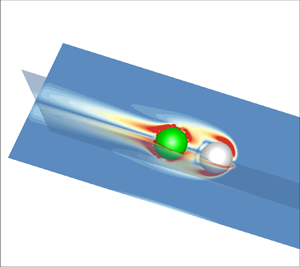Published online by Cambridge University Press: 20 March 2023

We numerically investigate the hydrodynamics of a spherical swimmer carrying a rigid cargo in a Newtonian fluid. This swimmer model, a ‘squirmer’, which is self-propelled by generating tangential surface waves, is simulated by a direct-forcing fictitious domain method (DF-FDM). We consider the effects of swimming Reynolds numbers (Re) (based on the radius and the swimming speed of the squirmers), the assembly models (related to the cargo shapes, the relative distances (ds) and positions between the squirmer and the cargo) on the assembly's locomotion. We find that the ‘pusher-cargo’ (pusher behind the cargo) model swims significantly faster than the remaining three models at the finite Re adopted in this study; the term ‘pusher’ indicates that the object is propelled from the rear, as opposed to ‘puller’, from the front. Both the ‘pusher-cargo’ and ‘cargo-pusher’ (pusher in front of the cargo) assemblies with an oblate cargo swim faster than the corresponding assemblies with a spherical or prolate cargo. In addition, the pusher-cargo model is significantly more efficient than the other models, and a larger ds yields a smaller carrying hydrodynamic efficiency η for the pusher-cargo model, but a greater η for the cargo-pusher model. We also illustrate the assembly swimming stability, finding that the ‘puller-cargo’ (puller behind the cargo) model is stable more than the ‘cargo-puller’ (puller in front of the cargo) model, and the assembly with a larger ds yields more unstable swimming.
To send this article to your Kindle, first ensure no-reply@cambridge.org is added to your Approved Personal Document E-mail List under your Personal Document Settings on the Manage Your Content and Devices page of your Amazon account. Then enter the ‘name’ part of your Kindle email address below. Find out more about sending to your Kindle. Find out more about saving to your Kindle.
Note you can select to save to either the @free.kindle.com or @kindle.com variations. ‘@free.kindle.com’ emails are free but can only be saved to your device when it is connected to wi-fi. ‘@kindle.com’ emails can be delivered even when you are not connected to wi-fi, but note that service fees apply.
Find out more about the Kindle Personal Document Service.
To save this article to your Dropbox account, please select one or more formats and confirm that you agree to abide by our usage policies. If this is the first time you used this feature, you will be asked to authorise Cambridge Core to connect with your Dropbox account. Find out more about saving content to Dropbox.
To save this article to your Google Drive account, please select one or more formats and confirm that you agree to abide by our usage policies. If this is the first time you used this feature, you will be asked to authorise Cambridge Core to connect with your Google Drive account. Find out more about saving content to Google Drive.